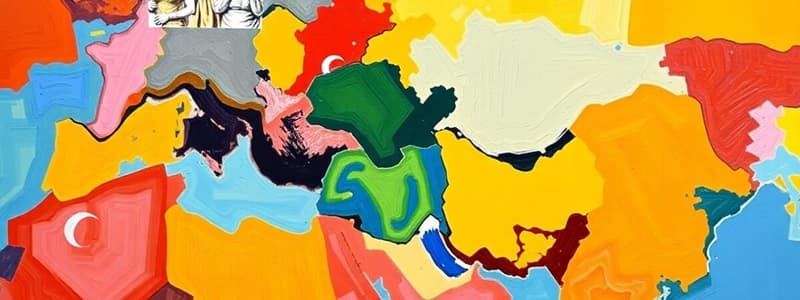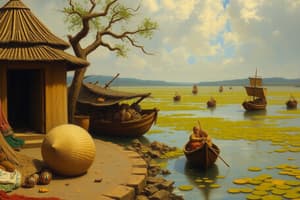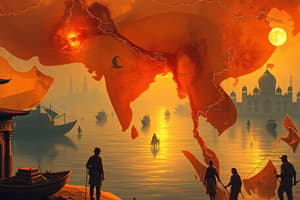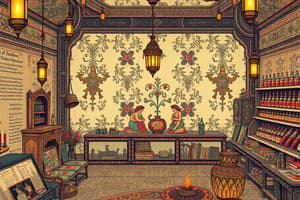Podcast
Questions and Answers
The trade with the West primarily involved items such as spices, textiles, and sugar.
The trade with the West primarily involved items such as spices, textiles, and sugar.
True (A)
The Arabs had no role in controlling trade between India and Europe.
The Arabs had no role in controlling trade between India and Europe.
False (B)
The rise of the Turks in 1453 had no impact on trade routes from India to Europe.
The rise of the Turks in 1453 had no impact on trade routes from India to Europe.
False (B)
Vasco da Gama was the first European to reach India by land.
Vasco da Gama was the first European to reach India by land.
The Mughal emperors perceived European traders as a significant threat during their rule.
The Mughal emperors perceived European traders as a significant threat during their rule.
The Portuguese were the first to establish a trading company in India.
The Portuguese were the first to establish a trading company in India.
Vasco da Gama established hostile relations with the zamorin of Calicut.
Vasco da Gama established hostile relations with the zamorin of Calicut.
European trading companies gained power and established colonies in India by the late 18th century.
European trading companies gained power and established colonies in India by the late 18th century.
Vasco da Gama captured Goa from the Sultan of Bijapur in 1510.
Vasco da Gama captured Goa from the Sultan of Bijapur in 1510.
The English East India Company was founded in 1600.
The English East India Company was founded in 1600.
The French East India Company was fully controlled by private merchants.
The French East India Company was fully controlled by private merchants.
The British acquired Bombay from the Dutch.
The British acquired Bombay from the Dutch.
The decline of Portuguese power was influenced by their lack of inland territories.
The decline of Portuguese power was influenced by their lack of inland territories.
Aurangzeb initially defeated the English East India Company when they attempted to capture Chittagong in 1685.
Aurangzeb initially defeated the English East India Company when they attempted to capture Chittagong in 1685.
Cochin was one of the significant trading centres established by the Dutch in India.
Cochin was one of the significant trading centres established by the Dutch in India.
Calcutta developed from three villages leased by the British in 1698.
Calcutta developed from three villages leased by the British in 1698.
By the end of the 16th century, the Portuguese had completely lost control over all their territories in India.
By the end of the 16th century, the Portuguese had completely lost control over all their territories in India.
Fort St. George was built by the British in Calicut.
Fort St. George was built by the British in Calicut.
Flashcards are hidden until you start studying
Study Notes
Trade Patterns and European Exploration
- India’s trade with the West included spices, textiles, sugar, indigo, and saltpetre, primarily controlled by Arab traders.
- Key trade routes involved transport through the Persian Gulf and Red Sea until the Ottoman Turks disrupted land routes in 1453.
- European nations sought maritime paths to India, prompting voyages by explorers like Bartolomeo Dias and Vasco da Gama.
Vasco da Gama’s Voyage
- Vasco da Gama reached India in 1498, becoming the first European to do so via sea by navigating around the Cape of Good Hope.
- His arrival established a direct sea-route to India, facilitating trade for other European nations including the Dutch, British, and French.
- Mughal emperors initially did not perceive European traders as threats, allowing them to gain privileges and establish trading posts along the coasts.
The Portuguese Dominance
- First to establish a trading company in India, the Portuguese maintained a monopoly on Indian trade throughout the 16th century via their naval strength.
- Key figures include Vasco da Gama, who formed alliances with local rulers such as the zamorin of Calicut and the ruler of Cochin.
- Albuquerque captured Goa in 1510, making it the headquarters of Portuguese operations.
- Decline began by the end of the 16th century due to weak leadership and competition from Dutch and British traders.
The Dutch East India Company
- Founded in 1602, the Dutch East India Company broke the Portuguese monopoly in the Indian Ocean by establishing trading centers in Surat, Chinsurah, Nagapatnam, and Cochin.
- Though they were initially a strong trading power, the Dutch focused more on Southeast Asia, allowing the British to gradually overshadow them in India.
The British East India Company
- Established in 1600, gaining royal permission from Queen Elizabeth I to trade in India with profits shared with the crown.
- Sir Thomas Roe represented the Company at Jahangir's court in 1615, gaining trading rights in Surat.
- Key developments included the establishment of Fort St. George in Madras and a factory in Hooghly by 1668.
- Transition from traders to rulers occurred as Sir Josiah Child aimed for an empire, with significant gains following the defeat of Aurangzeb's forces and tax rights in Bengal.
Emergence of Calcutta
- In 1698, the East India Company acquired rights to collect taxes in Sutanati, Kalikata, and Gobindapur which later became Calcutta.
- British fortified Hooghly, developing Fort William, leading to urbanization and commerce growth in colonies, attracting Indian merchants.
French Presence in India
- The French East India Company was established in 1664, directly controlled by the French government unlike the British counterpart.
- Key possessions included fortified trading centers at Pondicherry, Chandernagore, and Mahe, but they entered the Indian market later than the British.
Acquisition of Bombay
- The British gained Bombay through a royal marriage arrangement, receiving it as a dowry in 1668 and transferring it to the East India Company.
Colonial Legacy
- Indian cities reflect the influence of European colonizers with notable architecture like the Victoria Memorial in Kolkata and other French structures in Pondicherry.
- Colonial segregation is notable in urban planning with distinct areas for local and European populations.
Studying That Suits You
Use AI to generate personalized quizzes and flashcards to suit your learning preferences.




